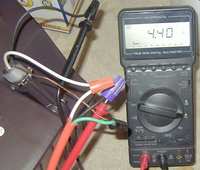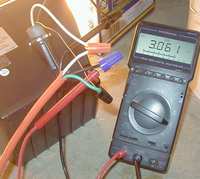Contributed by:
Basil Fawlty
Submitted: August 27th, 2004
Images archived:
2004

Have you ever looked
at your lamp and thought, "Hmm, the bulb says 150W but
surely this ballast thingy must use some power too" Well
if you did, youre absolutely right. Some people say that
the rule of thumb is about 5-10% of the lamp's wattage.
While this may be true for some ballasts, it certainly
isn't the case for all ballasts, particularly cheap HID
(High Intensity Discharge) lamp ballasts.
We
essentially want to know the ratio of the lamp wattage
(W) to total input power (VA, in Watts):
This is
called the
Power Factor.
A good ballast
will have a power factor above 0.9 (i.e. more than 90%
of the power it draws is used to power the bulb).
Cheaper (lower quality) ballasts often have power
factors of 0.5 or less. That's right, only half of the
power gets to the bulb. So a 150W lamp would be drawing
300W of power.
Let's look at a real world
example. Here's a 150W HPS lamp made by Globe. Notice
they claim that this 150W HPS is equivalent to 9
incandescent bulbs for a saving of 89% in energy costs.
This lamp has been used for about 8 months (about
4-5000hrs).

OK, let's take our trusty multimeter and
measure the voltage on our 120V line.
So now
we've measured V = 121.6V. We now set our multimeter to
measure AC current and plug the leads into the 10A slot
on it.
WARNING! Never put the leads in the 10A
slot for any purpose other than measuring
current! Failure to heed this warning will at
very least result in a tripped breaker and a blown fuse
inside your multimeter, if you're lucky.

We then wire the leads in series with
the black wires of the lamp. Let's turn on the lamp and
see what the startup current looks like.
Holy
cow! 4.4A! That means that it's using 121.6V x 4.4A =
535W! Let\'s figure out the power factor at startup.
Power Factor = W / VA = 150 / (121.6 x 4.4) =
0.28!
That means that only 28% of the power is
being used by the lamp. Let's not forget that it's
normal for HID lamps to draw more juice at startup.
Therefore, the lamp is probably drawing more than 150W
and is skewing our power factor calculation.
So
let's let it run for a while....

After a good fifteen minutes has gone
by, the light is at maximum intensity. Let's have a look
at the current flowing through the circuit now!
As we can see, it has indeed dropped. It's now
drawing 3.06A or 121.6 x 3.06 = 372W! Let's figure out
the power factor.
Power Factor = W / VA = 150 /
(121.6 x 3.06) = 0.4
It's important to
mention that as an HPS bulb ages, it draws more
power. I performed the same measurement when the
bulb was almost new and it was drawing 2.6-2.7A at
operating temperature then, which would give something
closer to a more realistic power factor of 0.5.
Since the power factor of the ballast doesn't
change much over time, we can work backwards to
determine how many watts the lamp is drawing part way
through its life:
W = PF x V x A = 0.5 x 121.6 x
3.06 = 186W.
To answer our initial question,
"How much power does my lamp really use?"
Bulb Wattage -> 150W
Power used at
Startup -> 535W
Power used at Operating ->
372W I think the most important thing to
learn here is that it costs almost as much to run a 150W
bulb on a low power factor ballast as it does to run a
400W bulb with a high power factor ballast.
It
should also be apparent that one should be careful about
the assumptions they make when making calculations for
the installation of electrical circuits. You may think
that you can safely put 7-8 of these 150W lamps on a 15A
circuit but guess again!
In the next
installment, I'll show you how to add a power factor
correction capacitor to increase the power factor of
your el cheapo ballast.